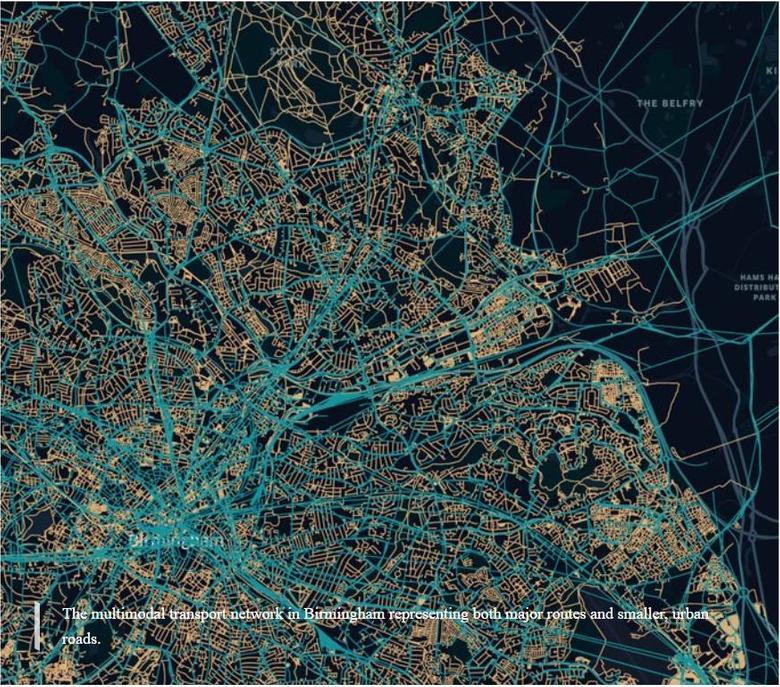Innovate UK: Birmingham's Agent Based Model
The COVID-19 pandemic has presented many unique challenges for transport planners and operators worldwide. We are now in an environment where baseline assumptions around how people move and behave in a city are no longer valid and are constantly changing. With transport being integral to the UK’s economic recovery, understanding individual transport behaviours has never been more important to inform COVID-19 response efforts.
Innovate UK, the UK’s innovation agency, awarded funding to Arup as part of their ‘Business-led innovation response to global disruption’ competition in the immediate wake of the UK’s lockdown. In just six weeks, we developed the foundations of an Agent Based Model (ABM), simulating individual behaviours and travel changes when regular behaviours were disrupted by the pandemic such as social distancing restrictions. This model forms the basis for future analysis – at the granular level of individual behaviour. Working in collaboration with Birmingham City Council and Transport for the West Midlands, we built an ABM for the Birmingham region to test our approach.
The project has required us to think differently. Testing radically different behaviours for which there is no precedent, required a new approach. Our aim was to demonstrate how advanced machine learning can be applied to reduce cost and increase the speed of planning for transportation services in uncertain environments.

Providing value faster
The COVID-19 pandemic has presented new challenges for traditional models, which can take months or years to build and simulate behaviours, and struggle to represent behaviour that looks different from the past. Our challenge was to develop the foundations of a model that could provide useful insight into these radical shifts in behaviour. We needed to work fast, and build the foundations of a model within weeks to help transport agencies plan for short- and medium-term consequences of changes in travel behaviours because of the pandemic.
ABMs simulate behaviours at an individual level. They take into consideration different characteristics, needs, and resources, providing the unique opportunity to reflect changes in behaviour during the pandemic. In contrast to traditional modelling, this granular approach provides the ability to consider futures that are radically different from the past and allows us to model a wide range of impacts with greater flexibility.

Modelling changing behaviours
As the UK’s second largest city, Birmingham was a prime location to test this approach. Working in collaboration with Birmingham City Council and Transport for the West Midlands, to understand their data and priorities for decision making during the lockdown we built a multimodal network of the West Midlands region. Using a combination of geographical data, timetable data and census data, we were able to build a baseline model to reflect transport behaviours pre-pandemic. The model was then used to run simulations to represent impacts of the pandemic and provided visualisations of the outputs.
Delivering a model in six weeks
Time was a critical consideration from the outset. With behaviours changing overnight as a result of new restrictions, we needed to be able to develop an ABM that simulated behaviours quickly. In the wake of the pandemic, our data scientists developed the Pandemic Activity Modifier (PAM). This open source pre-processing software alters the behaviour plans of agents based on the introduction of new government policies and allowed us to automate elements of our ABM and expedite its delivery.
In just six weeks, we developed a model that simulated approximately 200,000 individual agents - 10% of Birmingham’s population. The represented changes in travel behaviours compared favourably against our benchmark data, showing agents changing behaviour and shifting from public transport to private cars and allowed for more informed and knowledgeable conversations around the modelled scenario results. Using a traditional model, this would not have been possible.
The future roadmap
In parallel to the build of the ABM, we are setting out a roadmap for how the model could be enhanced. For instance, how and which communities might be most impacted by any changes to public transport services. These developments will help to answer specific questions around both the pandemic and transport interventions, in general, to support successful transport planning in our cities.
Author:
Nick Bec , London Data and Digital Leader, ARUP

